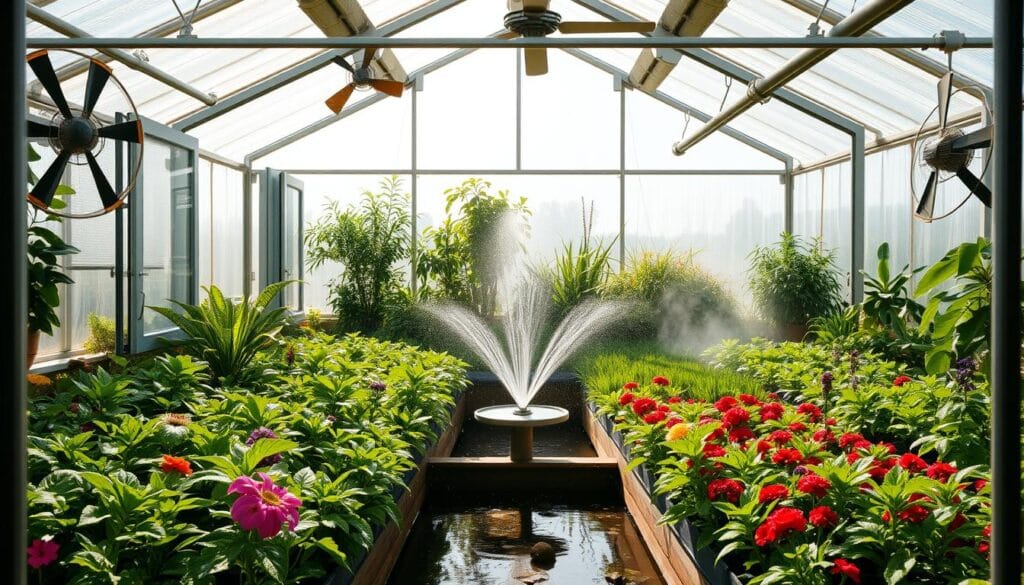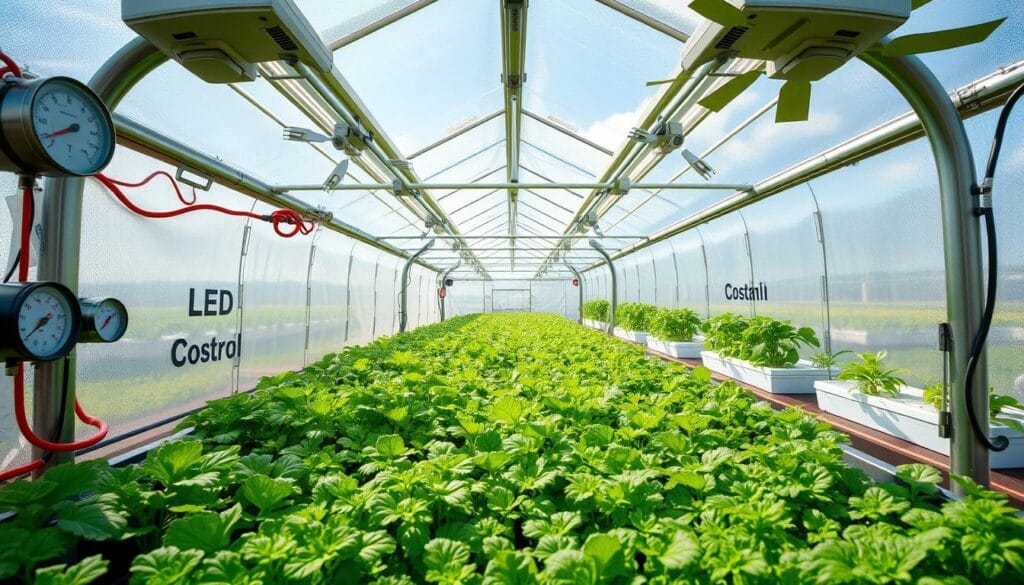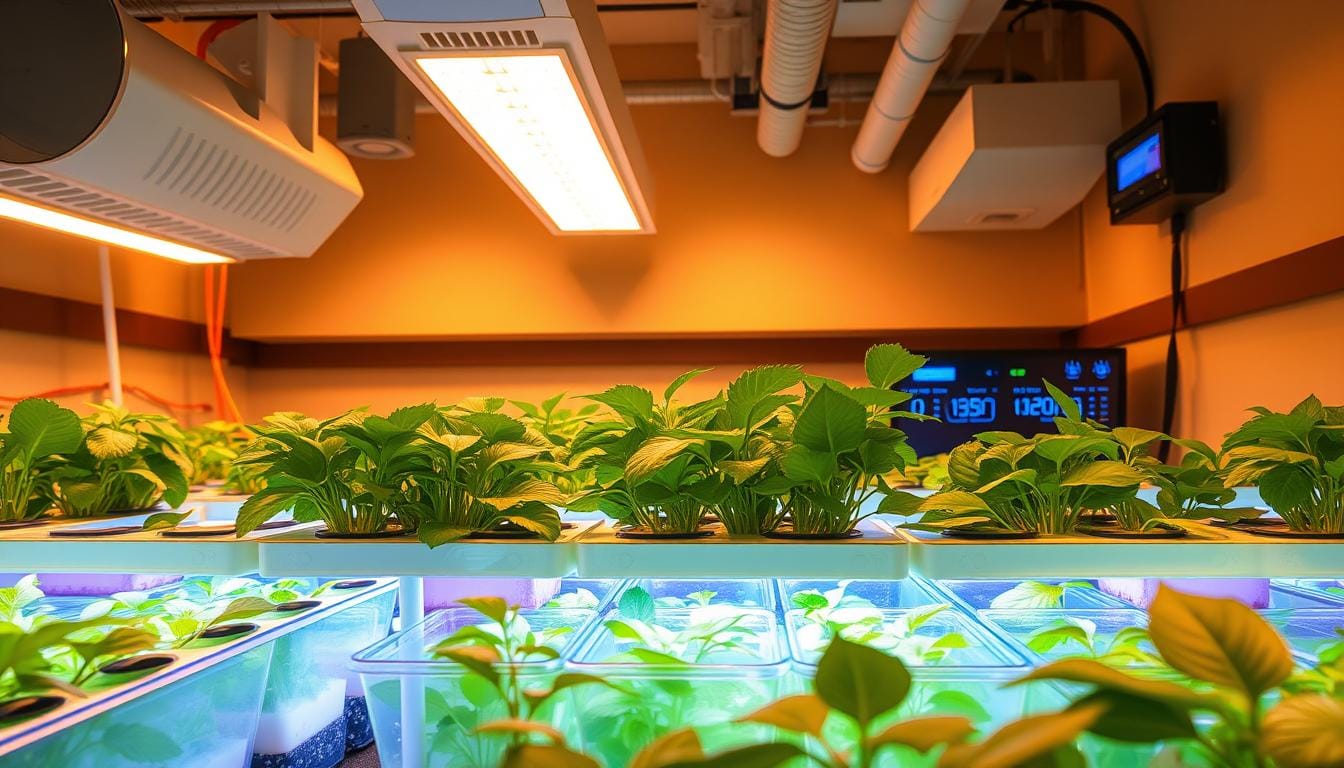Control Temperature and Humidity in Hydroponics to create the perfect growing environment for your plants. It’s not just about keeping things steady—it’s about crafting the ideal conditions for robust growth. By mastering temperature and humidity control, you’ll ensure your hydroponic plants thrive.
Knowing how to control the environment is vital in hydroponics. It helps avoid problems like root rot and nutrient shortages. With the right tools and knowledge, you can make a great space for your plants to thrive.
Key Takeaways
- Controlling temperature and humidity is key to hydroponic success
- Hydroponic climate control helps plants grow well
- Learning to control temperature and humidity prevents common issues
- Creating a stable environment is essential for healthy plants
- Mastering hydroponic climate control needs the right techniques and tools
Understanding the Crucial Role of Environmental Control in Hydroponics
Exploring hydroponics shows that controlling the environment is key. Managing the indoor space well affects your plants’ health and growth. This is why indoor farming environment management is so important. It involves the methods and plans for a perfect growing space.
In hydroponics, keeping the greenhouse temperature right is vital. Each plant needs a specific temperature and humidity level. Knowing these optimal hydroponic growing conditions helps your plants grow better and stay healthy. Some plants love warmer weather, while others do best in cooler temperatures.
Impact on Plant Growth and Development
Temperature and humidity greatly affect plant growth. Even small changes can harm your plants’ health and productivity. Knowing the best temperature ranges for each plant helps avoid problems. This way, you can create a space where plants can grow well.
Optimal Ranges for Different Crop Types
Here are some common crops and their ideal temperature ranges:
- Leafy greens: 60-70°F (15-21°C)
- Tomatoes: 65-75°F (18-24°C)
- Cucumbers: 70-80°F (21-27°C)
Common Environmental Challenges in Hydroponic Systems
Hydroponics has many benefits, but it faces some environmental challenges. These include temperature changes, humidity issues, and poor airflow. Knowing these problems and how to solve them helps create a great growing space. This space supports healthy plant growth and high yields.
Essential Equipment for Hydroponic Climate Management
To control the climate for hydroponics, you need the right tools. This includes heating and cooling systems, dehumidifiers, humidifiers, and ventilation. Each tool is key to keeping the perfect environment for plants to grow. For example, heaters keep the temperature right in cold months. Dehumidifiers stop too much moisture, which can cause mold and rot.
Humidity control is also vital. Some plants need a lot of moisture, while others prefer it dry. Using both humidifiers and dehumidifiers helps balance the humidity. Proper humidity control is key to stopping diseases and helping plants grow well.
Here are some key pieces of equipment to consider:
- Heating and cooling systems
- Dehumidifiers and humidifiers
- Ventilation systems
- Thermostats and hygrometers
Investing in this equipment helps create a climate control system that supports healthy plant growth. It also increases yields. Make sure to pick equipment made for hydroponics and follow the manufacturer’s setup and care tips.
How to Control Temperature and Humidity in Hydroponics: Core Methods
Keeping the right temperature and humidity is key for plants to grow well in hydroponics. You can use different methods like ventilation systems, heaters, coolers, and humidifiers. These tools help control the environment, making sure your plants thrive.
Ventilation Systems and Air Movement
Ventilation is vital to keep the air fresh and prevent CO2 buildup. Fans and vents help move air, keeping the temperature and humidity just right.
Heating and Cooling Solutions
Heaters and coolers are used to keep the temperature perfect for each plant’s needs. This varies based on the plant type and its growth stage.
Dehumidification Techniques and Humidification Strategies
Dehumidifiers stop moisture from causing diseases. Humidifiers, on the other hand, keep the air moist, which is important in dry places. By watching the temperature and humidity, you can adjust them as needed. This ensures your plants grow well.
| Method | Description |
|---|---|
| Ventilation Systems | Prevent CO2 buildup and maintain a healthy atmosphere |
| Heating and Cooling Solutions | Maintain optimal temperature range for crop growth |
| Dehumidification Techniques | Prevent moisture buildup and disease |
| Humidification Strategies | Maintain optimal humidity levels for crop growth |
Natural and Passive Climate Control Strategies
Hydroponic climate control can use natural and passive methods. These help cut down on mechanical systems and lower costs. For instance, shading can lessen heat gain, which is key for indoor farming.
Other passive methods include insulation for steady temperatures and placing plants for better airflow. These methods are efficient and save energy, making them a smart choice for your system.

- Use thermal mass materials to absorb and release heat
- Use natural ventilation to minimize reliance on mechanical cooling
- Implement a shading system to control the amount of sunlight entering the growing area
Adding these natural and passive strategies to your hydroponic system makes it more efficient and green. It’s good for your plants and helps the environment. Plus, it saves you money over time.
| strategy description | n |
|---|---|
| Shading | Reduces heat gain and prevents overheating |
| Insulation | Maintains consistent temperatures and reduces heat loss |
| Plant placement | Maximizes air circulation and reduces the need for mechanical cooling |
Advanced Monitoring Systems for Environmental Control
Investing in advanced monitoring systems is key for efficient climate control in hydroponics. These systems help keep the environment perfect for your plants to grow well. With digital controllers and automation, you can control temperature, humidity, and more precisely.
Digital Controllers and Automation
Digital controllers and automation let you make quick adjustments. This is vital for keeping your hydroponic system in top shape. It helps you react fast to any environmental changes.
Sensors and Data Logging
Sensors and data logging give you insights into your environment. They help you spot trends and issues early. By using this data, you can improve your strategies for a better environment for your plants.
Remote Monitoring Solutions
Remote monitoring solutions let you check and control your environment from anywhere. This is super helpful for big hydroponic setups. It makes keeping the climate right easier.
Cost-Effective Solutions for Temperature and Humidity Management
Managing temperature and humidity in hydroponics can be pricey. But, it doesn’t have to drain your wallet. You can find affordable ways to control these factors. Look for budget-friendly equipment, like DIY options or cheaper commercial products.
Energy-Efficient Practices
To cut down on costs, try energy-saving methods. LED grow lights use less power than old-school lighting. Also, designing your system wisely can help save energy. This way, you keep your plants happy and your wallet happy too.
Here are some budget-friendly ways to manage temperature and humidity:
- Use insulation to cut down on heat loss
- Get a climate control system that can be set to adjust levels
- Use natural airflow to lessen the need for cooling

With these cost-effective tips, you can manage temperature and humidity in hydroponics. This ensures your plants grow well. Remember, controlling the climate is key for your plants’ health. With smart choices, you can have a successful hydroponic system without spending too much.
Troubleshooting Common Environmental Issues
Keeping your indoor farm’s environment just right is key for a good harvest. Even with careful planning, problems can pop up. It’s important to spot these issues fast and fix them quickly.
Problems like temperature swings, humidity issues, and bad air flow are common. Figuring out the main cause is the first step to solving the problem. Start by checking your system’s temperature, humidity, and airflow.
To tackle these issues, follow these steps:
- Monitor the temperature and humidity levels of your system
- Look for any blockages in airflow and ventilation
- Adjust your climate control to keep things perfect for growing
By staying on top of these steps, you can quickly find and fix any problems. This ensures your crops get the best-growing conditions to thrive.
| Environmental Issue | Cause | Solution |
|---|---|---|
| Temperature fluctuations | Malfunctioning heating or cooling systems | Check and repair or replace heating or cooling systems as needed |
| Humidity imbalances | Inadequate ventilation or air circulation | Adjust ventilation and air circulation systems to maintain optimal humidity levels. |
| Poor air circulation | Blockages or obstructions in air circulation systems | Check and clear blockages or obstructions in air circulation systems |
Seasonal Adjustments for Optimal Growing Conditions
Managing your hydroponic system means making seasonal changes to keep plants thriving. Hydroponic climate control is key to this. Knowing what each season needs helps you adjust temperature and humidity levels.
In summer, keeping plants cool and well-ventilated is critical. Use shading, cooling systems, and air circulation for this. Winter needs careful heating to keep temperatures right. Spring and fall need attention too, as temperatures and humidity can change a lot.
Summer Management Techniques
- Use shading materials to prevent overheating
- Implement cooling systems, such as evaporative coolers or misting systems
- Ensure proper air circulation through ventilation systems
Winter Control Strategies
- Use heating systems, such as space heaters or heat pumps, to maintain optimal temperatures
- Insulate the growing area to minimize heat loss
- Monitor temperature and humidity levels closely to prevent over-humidification
Spring and Fall Transitions
Spring and fall are times of big changes in temperature and humidity. Adjusting your temperature and humidity monitoring in hydroponics helps plants adjust smoothly. This keeps them growing well.
| Season | Temperature Range | Humidity Level |
|---|---|---|
| Summer | 65-75°F (18-24°C) | 40-60% |
| Winter | 55-65°F (13-18°C) | 30-50% |
| Spring/Fall | 60-70°F (16-21°C) | 40-60% |
Conclusion: Mastering Environmental Control for Successful Hydroponics
Controlling temperature and humidity is key for successful hydroponics. Keeping the ideal environment for your hydroponic plants lets them grow well. This way, you can get high-quality yields all the time.
This guide has shown you how to manage temperature and humidity in hydroponics. You now know how to control the environment. It’s important to keep checking and adjusting to make sure your plants do well.
Use what you’ve learned from this article to become a great hydroponic grower. You’ll be able to make the best conditions for your plants to grow. With the right steps, you can make hydroponics work for you and enjoy a big, sustainable harvest.

